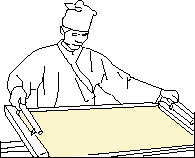

The History of Rice Paper
The Birthplace of Rice Paper
Xuancheng is the place where rice paper originally came from. The name of the paper was mentioned in many historical accounts from as early as the 8th century, but it was owing to Cao Family Genealogy, which was complied during the Qing, papermaking in this mountainous area in the hinterland of south China had a record. Around 1127, according to this genealogy, Cao family settled in Little Ridge of Xuancheng to evade warfare then. With limited cultivable farmland, the family took papermaking as a means of life as many other locals did. In the following centuries they were the only papermaker in the area. To the fifteenth century, when Chinese government was named Ming, the craft of papermaking here was fully developed with increased varieties. To the Manchu dynasty Qing the production of rice paper expanded to a large scale. As new paper mills grew into neighboring towns, people who were not of the same surname began to participate. Two major papermakers then were Cao and Wang family, and their makes continued into modern times.
In modern times Little Ridge experienced some ups and downs. In 1851, the largest peasant uprising in Chinese history broke out. The seesaw battle at Xuancheng lasted for ten years. To the time when the chaos ended, more than half of the population in Little Ridge was lost and scarcely a roof was still on four walls. Starting from scratch, papermakers took many years to revive their trade. Reaching new prosperity from 1921 to 1937, Little Ridge's then 44 paper mills could produce hundred tons of rice paper each year. However, World War II soon broke out, after which only 10 paper mills survived. The following Civil War completely destroyed the industry, when all businesses were closed.

The history of rice paper
Home | Contact | Rice Paper